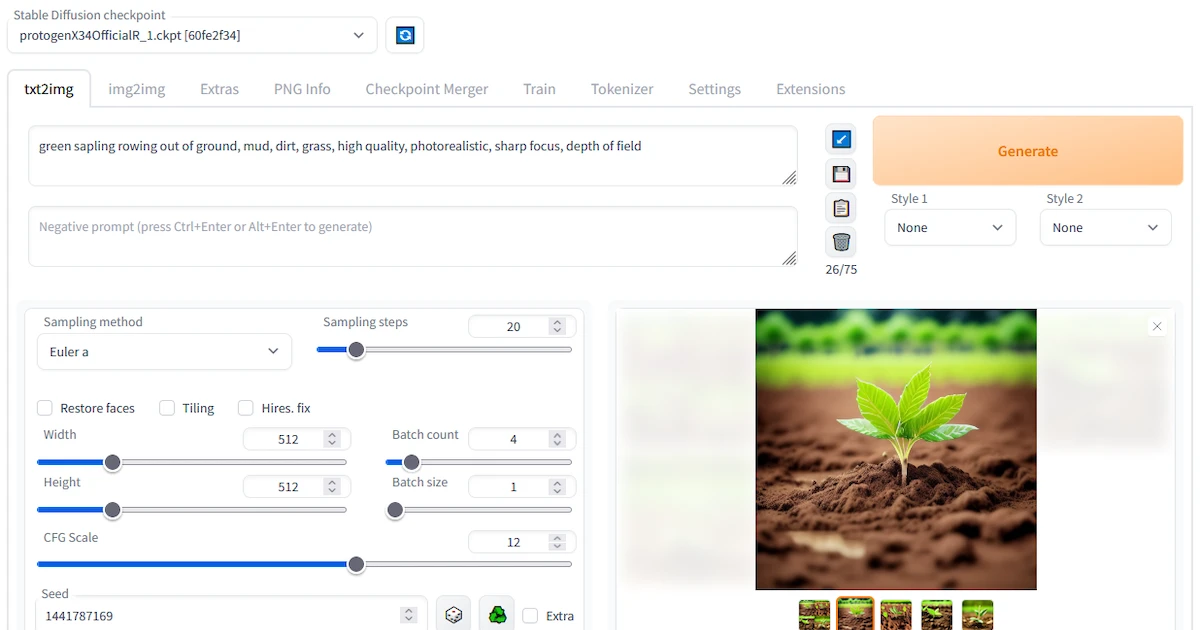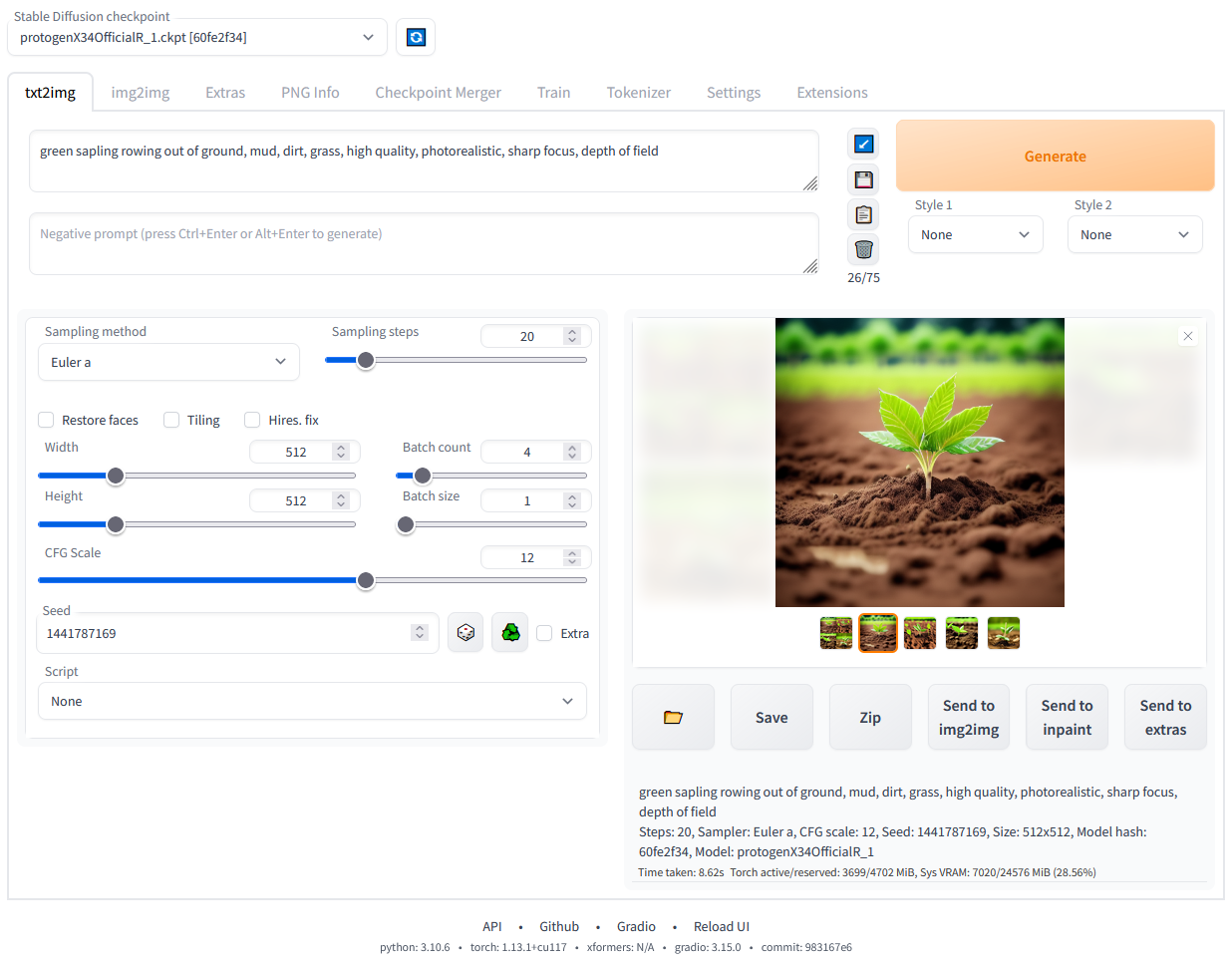
A1111 WebUI
130.2k 25.0kWhat is Stable Diffusion Web UI ?
Stable Diffusion Web UI is a Gradio browser interface for the Generative AI model Stable Diffusion.
Stable Diffusion Web UI Features
Detailed feature showcase with images:
-
Original txt2img and img2img modes
-
One click install and run script (but you still must install python and git)
-
Outpainting
-
Inpainting
-
Color Sketch
-
Prompt Matrix
-
Stable Diffusion Upscale
-
Attention, specify parts of text that the model should pay more attention to
-
a man in a
((tuxedo))- will pay more attention to tuxedo -
a man in a
(tuxedo:1.21)- alternative syntax -
select text and press
Ctrl+UporCtrl+Down(orCommand+UporCommand+Downif you’re on a MacOS) to automatically adjust attention to selected text (code contributed by anonymous user)
-
-
Loopback, run img2img processing multiple times
-
X/Y/Z plot, a way to draw a 3 dimensional plot of images with different parameters
-
Textual Inversion
-
have as many embeddings as you want and use any names you like for them
-
use multiple embeddings with different numbers of vectors per token
-
works with half precision floating point numbers
-
train embeddings on 8GB (also reports of 6GB working)
-
-
Extras tab with:
-
GFPGAN, neural network that fixes faces
-
CodeFormer, face restoration tool as an alternative to GFPGAN
-
RealESRGAN, neural network upscaler
-
ESRGAN, neural network upscaler with a lot of third party models
-
SwinIR and Swin2SR (see here), neural network upscalers
-
LDSR, Latent diffusion super resolution upscaling
-
-
Resizing aspect ratio options
-
Sampling method selection
-
Adjust sampler eta values (noise multiplier)
-
More advanced noise setting options
-
-
Interrupt processing at any time
-
4GB video card support (also reports of 2GB working)
-
Correct seeds for batches
-
Live prompt token length validation
-
Generation parameters
-
parameters you used to generate images are saved with that image
-
in PNG chunks for PNG, in EXIF for JPEG
-
can drag the image to PNG info tab to restore generation parameters and automatically copy them into UI
-
can be disabled in settings
-
drag and drop an image/text-parameters to promptbox
-
-
Read Generation Parameters Button, loads parameters in promptbox to UI
-
Settings page
-
Running arbitrary python code from UI (must run with
--allow-codeto enable) -
Mouseover hints for most UI elements
-
Possible to change defaults/mix/max/step values for UI elements via text config
-
Tiling support, a checkbox to create images that can be tiled like textures
-
Progress bar and live image generation preview
- Can use a separate neural network to produce previews with almost none VRAM or compute requirement
-
Negative prompt, an extra text field that allows you to list what you don’t want to see in generated image
-
Styles, a way to save part of prompt and easily apply them via dropdown later
-
Variations, a way to generate same image but with tiny differences
-
Seed resizing, a way to generate same image but at slightly different resolution
-
CLIP interrogator, a button that tries to guess prompt from an image
-
Prompt Editing, a way to change prompt mid-generation, say to start making a watermelon and switch to anime girl midway
-
Batch Processing, process a group of files using img2img
-
Img2img Alternative, reverse Euler method of cross attention control
-
Highres Fix, a convenience option to produce high resolution pictures in one click without usual distortions
-
Reloading checkpoints on the fly
-
Checkpoint Merger, a tab that allows you to merge up to 3 checkpoints into one
-
Custom scripts with many extensions from community
-
Composable-Diffusion, a way to use multiple prompts at once
-
separate prompts using uppercase
AND -
also supports weights for prompts:
a cat :1.2 AND a dog AND a penguin :2.2
-
-
No token limit for prompts (original stable diffusion lets you use up to 75 tokens)
-
DeepDanbooru integration, creates danbooru style tags for anime prompts
-
xformers, major speed increase for select cards: (add
--xformersto commandline args) -
via extension: History tab: view, direct and delete images conveniently within the UI
-
Generate forever option
-
Training tab
-
hypernetworks and embeddings options
-
Preprocessing images: cropping, mirroring, autotagging using BLIP or deepdanbooru (for anime)
-
-
Clip skip
-
Hypernetworks
-
Loras (same as Hypernetworks but more pretty)
-
A separate UI where you can choose, with preview, which embeddings, hypernetworks or Loras to add to your prompt
-
Can select to load a different VAE from settings screen
-
Estimated completion time in progress bar
-
API
-
Support for dedicated inpainting model by RunwayML
-
via extension: Aesthetic Gradients, a way to generate images with a specific aesthetic by using clip images embeds (implementation of https://github.com/vicgalle/stable-diffusion-aesthetic-gradients)
-
Stable Diffusion 2.0 support - see wiki for instructions
-
Alt-Diffusion support - see wiki for instructions
-
Now without any bad letters!
-
Load checkpoints in safetensors format
-
Eased resolution restriction: generated image’s dimensions must be a multiple of 8 rather than 64
-
Now with a license!
-
Reorder elements in the UI from settings screen
-
Segmind Stable Diffusion support
Installation and Running
Make sure the required dependencies are met and follow the instructions available for:
-
NVidia (recommended)
-
AMD GPUs.
-
Intel CPUs, Intel GPUs (both integrated and discrete) (external wiki page)
Alternatively, use online services (like Google Colab):
Installation on Windows 10/11 with NVidia-GPUs using release package
-
Download
sd.webui.zipfrom v1.0.0-pre and extract its contents. -
Run
update.bat. -
Run
run.bat.
For more details see Install-and-Run-on-NVidia-GPUs
Automatic Installation on Windows
-
Install Python 3.10.6 (Newer version of Python does not support torch), checking “Add Python to PATH”.
-
Install git.
-
Download the stable-diffusion-webui repository, for example by running
git clone https://github.com/AUTOMATIC1111/stable-diffusion-webui.git. -
Run
webui-user.batfrom Windows Explorer as normal, non-administrator, user.
Automatic Installation on Linux
- Install the dependencies:
# Debian-based:
sudo apt install wget git python3 python3-venv libgl1 libglib2.0-0
# Red Hat-based:
sudo dnf install wget git python3 gperftools-libs libglvnd-glx
# openSUSE-based:
sudo zypper install wget git python3 libtcmalloc4 libglvnd
# Arch-based:
sudo pacman -S wget git python3- Navigate to the directory you would like the webui to be installed and execute the following command:
wget -q https://raw.githubusercontent.com/AUTOMATIC1111/stable-diffusion-webui/master/webui.sh-
Run
webui.sh. -
Check
webui-user.shfor options.
Installation on Apple Silicon
Find the instructions here.
Demo
